新人教版八年级下册英语全册教案
(完整版)英语人教版八年级下册英语教学设计
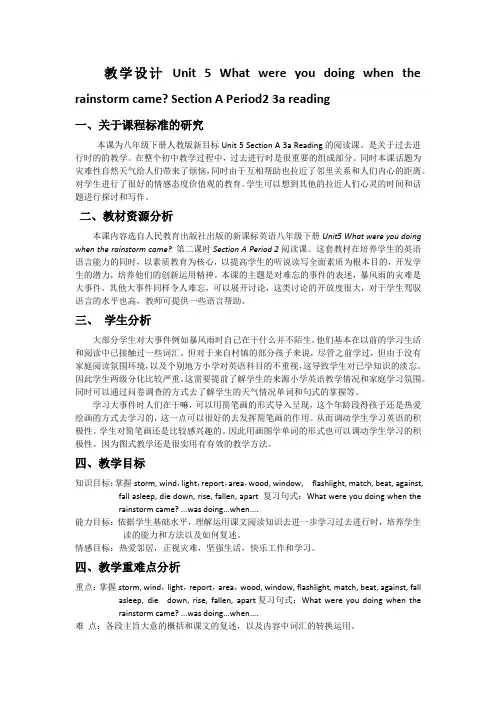
教学设计Unit 5 What were you doing when the rainstorm came? Section A Period2 3a reading一、关于课程标准的研究本课为八年级下册人教版新目标Unit 5 Section A 3a Reading的阅读课。
是关于过去进行时的的教学。
在整个初中教学过程中,过去进行时是很重要的组成部分。
同时本课话题为灾难性自然天气给人们带来了烦恼,同时由于互相帮助也拉近了邻里关系和人们内心的距离。
对学生进行了很好的情感态度价值观的教育。
学生可以想到其他的拉近人们心灵的时间和话题进行探讨和写作。
二、教材资源分析本课内容选自人民教育出版社出版的新课标英语八年级下册Unit5 What were you doing when the rainstorm came?第二课时Section A Period 2阅读课。
这套教材在培养学生的英语语言能力的同时,以素质教育为核心,以提高学生的听说读写全面素质为根本目的,开发学生的潜力,培养他们的创新运用精神。
本课的主题是对难忘的事件的表述,暴风雨的灾难是大事件,其他大事件同样令人难忘,可以展开讨论,这类讨论的开放度很大,对于学生驾驭语言的水平也高,教师可提供一些语言帮助。
三、学生分析大部分学生对大事件例如暴风雨时自己在干什么并不陌生,他们基本在以前的学习生活和阅读中已接触过一些词汇。
但对于来自村镇的部分孩子来说,尽管之前学过,但由于没有家庭阅读氛围环境,以及个别地方小学对英语科目的不重视,这导致学生对已学知识的淡忘。
因此学生两级分化比较严重。
这需要提前了解学生的来源小学英语教学情况和家庭学习氛围。
同时可以通过问卷调查的方式去了解学生的天气情况单词和句式的掌握等。
学习大事件时人们在干嘛,可以用简笔画的形式导入呈现,这个年龄段得孩子还是热爱绘画的方式去学习的,这一点可以很好的去发挥简笔画的作用。
从而调动学生学习英语的积极性。
八年级英语下册教案(全册英文)
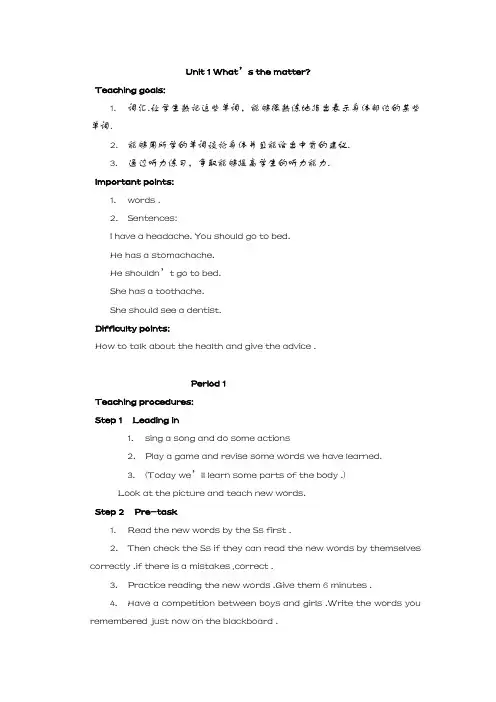
Unit 1 What’s the matter?Teaching goals:1.词汇.让学生熟记这些单词,能够很熟练地指出表示身体部位的某些单词.2.能够用所学的单词谈论身体并且能给出中肯的建议.3.通过听力练习,争取能够提高学生的听力能力.Important points:1.words .2.Sentences:I have a headache. You should go to bed.He has a stomachache.He shouldn’t go to bed.She has a toothache.She should see a dentist.Difficulty points:How to talk about the health and give the advice .Period 1Teaching procedures:Step 1 Leading in1.sing a song and do some actions2.Play a game and revise some words we have learned.3.(Today we’ll learn some parts of the body .)Look at the picture and teach new words.Step 2 Pre-task1.Read the new words by the Ss first .2.Then check the Ss if they can read the new words by themselves correctly .if there is a mistakes ,correct .3.Practice reading the new words .Give them 6 minutes .4.Have a competition between boys and girls .Write the words you remembered just now on the blackboard .Page7, 1a.Do this part by the Ss first. Write the correct letter after the name of each body part on the listPlay a game .All the Ss close your books ,we’ll have a instructor to say :Touch your nose /head /right ear ….Let’s see which student do it correctly and quickly .First all the Ss do this game .Then have competitions between boys and girls .5 boys and 5girls to the front to do what the instructor said .if you are wrong ,please go back to your seats ,the last one who stands at the front is the winner .Step 3 While-task1.Look at the picture and learn the main sentences.A: What’s the matter with you ?B: I have a cold.2. SB Page 7,1c Look at the pictures , work in pairs and act out.3. SB Page 7, 1b .(1) Listen and check the answers .(2) Listen and fill in the blanks.Step 4 Post-task同桌之间设计一个医生与病人之间的对话.Step 5. Exercises in classPeriod 2Teaching procedures :Step 1 Leading in1.Revise : Ask several pairs of students to the front of theclassroom to act out the dialogue:What’s the matter with you ?I have a sore throat.Then ask others : What’s the matter with him/her ?Help Ss answer : He has a sore throat. He should drink lots of water.2.look at pictures and practise the dialogue.Step 2 While-taskSB Page 8, 2a1.Point out the eight items in this activity .Read the item to the class .Ss repeat .2.There are different conversations .Listen carefully . people are talking about health problems they have and getting advice .3.Match the problems with the advice .4.Check the answers .SB Page 8, 2b .Pay attention to the four pictures .1.Each of these pictures illustrates one of the conversations .2.Play the tape ,write the missing words on the blank lines .3.Play the tape again and check the answers .4.Pairwork. Practice reading the dialogues in the pictures .Take turns having the problem and giving the advice .5.Practice reading the dialogue in 2c ,and make their onw conversations .6.Act out the dialogue .SB Page 9, 3a .1.Point out the picture and ask Ss to describe it .(There is a boy sitting on a bench .He’s sick .A teacher is talking to him )2.Pay attention to the dialogue and the blanks in the dialogue .3.Fill in the blanks in the conversation .4.Go over the answers.5.Practice reading the dialogue with a student, then work in pairs . Step 3 Post-taskSB Page 9 , 3b .1.Look at the picture and make your own dialogues setting 3a as an example .2.Act out the dialogue .Ask some pairs to come to the front to act out their onw dialogues .SB Page 9, Part 4. w W w . x K b 1.c o M1.Read the instructions and demonstrate what a “mime”is .2.Read the dialogue by the Ss .3.Ask a student to come to the front and mime an illness ,the other Ss guess what the illness is .4.Ask one student to give advice .5.Give several students an opportunity to come to the front and mime an illness .Step 4Exercises in classHomework1.When you had some problems. Please remember what the doctor said .Remember the new words .Period 3Teaching procedures :Step 1 Leading1.Play the game :One student mimes an illness , the other students guess the illness and give advice .What’s the matter? Do you have a sore throat ?2. Revise how to talk about health and give advice.Step 2 Pre-taskSB Page 10 ,1a .1.Look at the picture .Point out the four new words and expressions .Say each word and ask Ss to repeat .2.The first picture .Explain something about it using one of the four words and expressions .3.Match the words with the pictures by the Ss .4.Check the answers .5.Practice reading and make sure the Ss understand the meaning of the words .SB Page 10 ,1b1.Read the four sentences ,Ss practice reading .2.Look at the picture and match each picture with advice.3.Check the answerStep 3 While-taskSB Page 10 ,2a & 2b .1.First ,make sure the Ss understand what they will hear .2.Then read the four names3.Listen and write the problems on the bland lines .If possible ,write what each person “should”and “shouldn’t”do for their problem.4.Check the answers .Step 4 Post-taskSB Page 10,2c .1.Ask two students to read the conversation to the class .2.Pairwork .Make conversations with your partner .3.Act out the conversations for the class .4.Write two dialogues in the exercise book .5.Exercises in classPeriod 4Teaching procedures :Step 1 LeadingDiscussion: how to keep healthy.Step 2 While taskSB Page 11, 3a1.Read the article and fill in the form.2.Check the answers .3.Explanation4.ExercisesStep 3 Post taskSB Page 11, 3bLet the Ss read the paragraph and fill in the blanks .Check the answers .SB Page 11 ,Part 4.Play the gamePeriod 5 Self checkSB Page 12 , Part 1 .1.Fill in the blanks on their own .2.Make your own sentences with the words .SB Page 12, Part 2.Read the letter .Make sure Ss can understand it . Step 6 Homework1.Remember the words in this unit .2. Do the exercises on Pages 6-8of the workbook . 【课后反思】Unit 2 I’ll help clean up the city parksUnit 2 Section A 1a-Grammar Focus【学习目标】1.重点词汇用法及短语动词用法。
八年级下册英语教案(精选7篇)
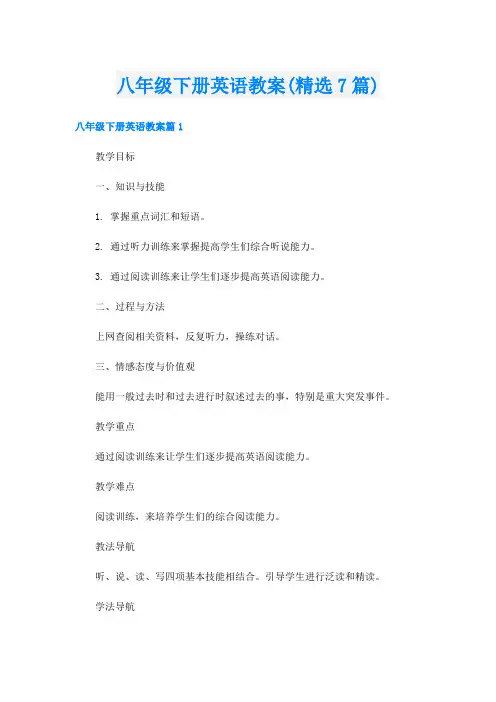
八年级下册英语教案(精选7篇)八年级下册英语教案篇1教学目标一、知识与技能1. 掌握重点词汇和短语。
2. 通过听力训练来掌握提高学生们综合听说能力。
3. 通过阅读训练来让学生们逐步提高英语阅读能力。
二、过程与方法上网查阅相关资料,反复听力,操练对话。
三、情感态度与价值观能用一般过去时和过去进行时叙述过去的事,特别是重大突发事件。
教学重点通过阅读训练来让学生们逐步提高英语阅读能力。
教学难点阅读训练,来培养学生们的综合阅读能力。
教法导航听、说、读、写四项基本技能相结合。
引导学生进行泛读和精读。
学法导航通过多种形式的运用,培养各种能力。
教学准备图片,多媒体。
教学过程Step 1 GreetingsGreet the students as usual.Step 2 RevisionAsk some students to report their dialogues.Step 3 Presentation1a, Think of a time when you were late for or couldn’t go to an event. What was the event? What was the reason why you were late or couldn’t go? Tell your partner the story. Then ask some students to tell their stories.Step 4 ListeningWhat happened to the girl? Let’s listen.1b, Listen and write short answers to the questions.1. What event happened at the school yesterday?2. Who missed the event?3. Which team won at the event?Play the recording at least twice and give the students enough time to write down their answers. Then ask some students to report their answers.1c, Listen again. Number the events [1-6] in the order they happened.____ Kate saw a dog by the side of the road.____ Kate got to the bus stop.____ Kate called the Animal Helpline.1 Kate left the house.____ Kate waited for someone to walk by.____ Kate realized her bag was still at home.Ask some students to report their answers.Step 5 Speaking1d, Talk about why Kate missed the school basketball competition. Student A begins a sentence with while or when. Student B completes the sentence.A:When she got to the bus stop,Kate …B:When she got to the bus stop,Kate realized that her bag was still at home.A:While she was running back home,…B:While she was running back home,she saw a dog by the side of the road.Encourage the students to make up as many dialogues as possible.Step 6 Presentation2a, Look at the pictures and the title in the passage. What do you think the passage is about?Remind the students to talk about it in pairs. Then ask some students to report their answers.Step 7 Reading2b, Read the passage and answer the questions:1. What are the two events in the passage?2. When did they happen?Ask some students to report their answers.2c Read the passage again. Are the following statements true (T) or false (F),or is the information not given (NG)?___ 1. Everyone in America remembers who killed Dr. King.___ 2. Robert Allen was eating lunch when Dr. King was killed.___ 3. Robert’s parents were shocked to hear the news.___ 4. Kate Smith was watching a movie when a plane hit the World Trade Center.___ 5. Kate didn’t think her friend was telling the truth about the event.Ask some students to report their answers.2d Underline sentences from the passage with similar meanings to the ones below.1. Not everyone will remember who killed him,but they can remember what they were doing when they heard that he got killed.2. No one said anything for the rest of dinner.3. September 11,2001—— the date alone means something to most people in the US.4. I had trouble thinking clearly after that because I was very afraid.Ask the students to read the passage carefully and try to find out the answers.Step 8 Language points1.My parents did not talk after that,and we finished the rest of our dinner in silence.in silence 沉默,无声e.g. Many patients were waiting in silence. 许多病人在静静地等候着。
新版人教版八年级英语下册全册教案
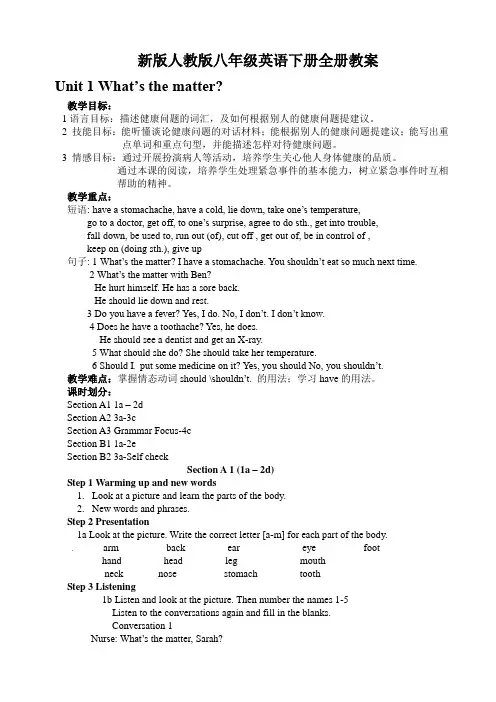
新版人教版八年级英语下册全册教案Unit 1 What’s the matter?教学目标:1语言目标:描述健康问题的词汇,及如何根据别人的健康问题提建议。
2 技能目标:能听懂谈论健康问题的对话材料;能根据别人的健康问题提建议;能写出重点单词和重点句型,并能描述怎样对待健康问题。
3 情感目标:通过开展扮演病人等活动,培养学生关心他人身体健康的品质。
通过本课的阅读,培养学生处理紧急事件的基本能力,树立紧急事件时互相帮助的精神。
教学重点:短语: have a stomachache, have a cold, lie down, take one’s temperature,go to a doctor, get off, to one’s surprise, agree to do sth., get into trouble,fall down, be used to, run out (of), cut off , get out of, be in control of ,keep on (doing sth.), give up句子: 1 What’s the matter? I have a stomachache. You shouldn’t eat so much next time.2 What’s the matter with Ben?He hurt himself. He has a sore back.He should lie down and rest.3 Do you have a fever? Yes, I do. No, I don’t. I don’t know.4 Does he have a toothache? Yes, he does.He should see a dentist and get an X-ray.5 What should she do? She should take her temperature.6 Should I put some medicine on it? Yes, you should No, you shouldn’t.教学难点:掌握情态动词should \shouldn’t. 的用法;学习have的用法。
人教版八年级英语下册教案全册
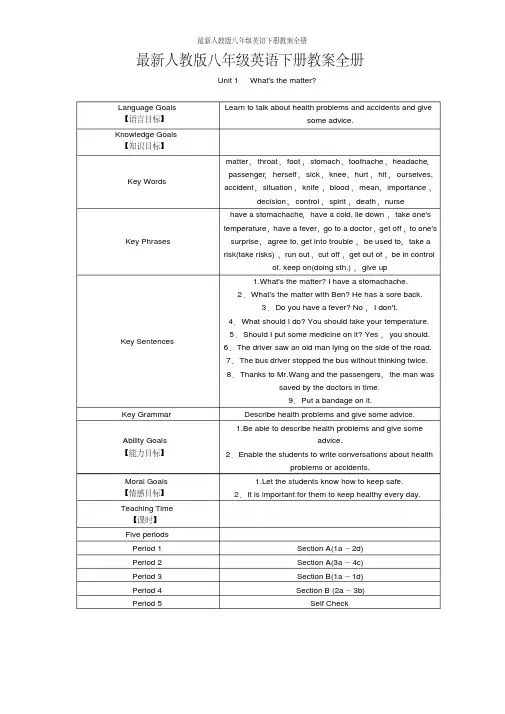
最新人教版八年级英语下册教案全册Unit 1What's the matter?Language Goals 【语言目标】Learn to talk about health problems and accidents and givesome advice.Knowledge Goals 【知识目标】Key Words matter,throat,foot,stomach,toothache,headache,passenger,herself,sick,knee,hurt,hit,ourselves, accident,situation,knife,blood,mean,importance,decision,control,spirit,death,nurseKey Phraseshave a stomachache,have a cold, lie down,take one's temperature,have a fever,go to a doctor,get off,to one's surprise,agree to, get into trouble,be used to,take a risk(take risks),run out,cut off,get out of,be in control of, keep on(doing sth.),give upKey Sentences1.What's the matter? I have a stomachache.2.What's the matter with Ben? He has a sore back.3.Do you have a fever? No,I don't.4.What should I do? You should take your temperature. 5.Should I put some medicine on it? Yes,you should. 6.The driver saw an old man lying on the side of the road. 7.The bus driver stopped the bus without thinking twice. 8.Thanks to Mr.Wang and the passengers,the man wassaved by the doctors in time.9.Put a bandage on it.Key Grammar Describe health problems and give some advice.Ability Goals 【能力目标】1.Be able to describe health problems and give someadvice.2.Enable the students to write conversations about healthproblems or accidents.Moral Goals 【情感目标】1.Let the students know how to keep safe. 2.It is important for them to keep healthy every day.Teaching Time【课时】Five periodsPeriod 1Section A(1a-2d) Period 2Section A(3a-4c) Period 3Section B(1a-1d) Period 4Section B (2a-3b) Period 5Self Check本单元教材以“What's the matter?”为中心话题,围绕着询问及描述“身体状况”进行学习和运用几个常见的句型:What's the matter? I have a stomachache./What's the matter with Ben? He has a sore back./Do you havea fever?No,I don't./What should I do? You should take your temperature./ Should I put some medicine on it? Yes,you should.等。
人教版八年级英语下册教学计划(10篇)
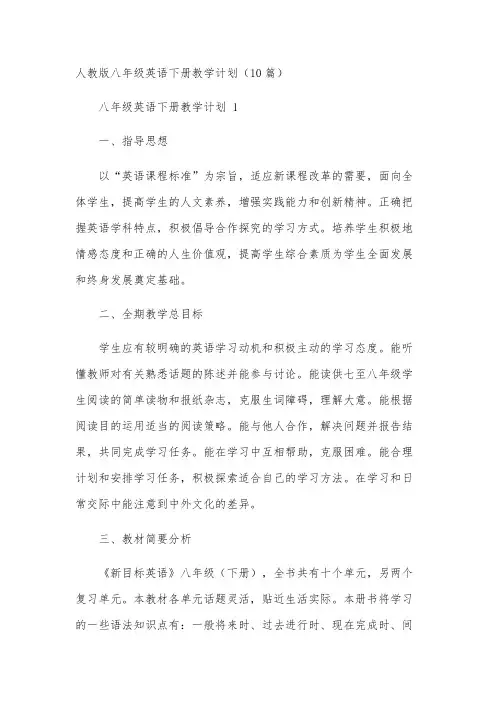
人教版八年级英语下册教学计划(10篇)八年级英语下册教学计划 1一、指导思想以“英语课程标准”为宗旨,适应新课程改革的需要,面向全体学生,提高学生的人文素养,增强实践能力和创新精神。
正确把握英语学科特点,积极倡导合作探究的学习方式。
培养学生积极地情感态度和正确的人生价值观,提高学生综合素质为学生全面发展和终身发展奠定基础。
二、全期教学总目标学生应有较明确的英语学习动机和积极主动的学习态度。
能听懂教师对有关熟悉话题的陈述并能参与讨论。
能读供七至八年级学生阅读的简单读物和报纸杂志,克服生词障碍,理解大意。
能根据阅读目的运用适当的阅读策略。
能与他人合作,解决问题并报告结果,共同完成学习任务。
能在学习中互相帮助,克服困难。
能合理计划和安排学习任务,积极探索适合自己的学习方法。
在学习和日常交际中能注意到中外文化的差异。
三、教材简要分析《新目标英语》八年级(下册),全书共有十个单元,另两个复习单元。
本教材各单元话题灵活,贴近生活实际。
本册书将学习的一些语法知识点有:一般将来时、过去进行时、现在完成时、间接引语、时间状语从句、条件状语从句、反意疑问句等。
同时每个单元后都提供了一篇阅读文章,用以训练学生的阅读能力,扩大学生的阅读量。
四、学情简要分析八年级共有四个教学班,通过初一年半的英语学习,大多数学生已能听懂有关熟悉话题的语段和简短的故事。
能与教师或同学就熟悉的话题交换信息。
能读懂短篇故事,能写便条和简单的书信。
但由于各种因素的.影响,学生发展参差不齐。
有少数学生因为基础不够好,学习很吃力。
五、提高教学质量的可行措施及教改措施1、面向全体学生,注重素质教育。
2、以学生为主体,尊重学生个体差异。
3、采用活动途径,倡导体验与参与。
4、开发课程资源,拓展学用渠道。
具体来说:1.认真专研教材和课标,精心备课,认真上好每一堂课。
确定每堂课的基础内容,预备内容和拓展内容,满足不同层次学生的不同需求。
2.充分利用现有的现代化教学设备,加强直观教学,提高课堂效率。
人教版八年级下册英语教案(全册)
人教版八年级下册英语教案(全册)Unit1What’s the matter?Section A◆教材分析本单元的主题是有关于身体健康。
这个话题是关乎我们每天的日常生活,所以有必要让学生了解相关的知识。
学生将会学会如何谈论他们的健康问题以及如何给予他人建议。
◆教学目标【知识目标】描述健康问题以及如何根据别人的健康问题提建议【能力目标】1.听懂谈论健康问题的对话材料2.能根据别人的健康问题提建议3.能写出重点单词和重点句型4.能描述怎样对待健康问题。
【情感目标】通过本课的阅读,培养学生关心他人身体健康的品质,并培养学生处理紧急事件的基本能力,树立在紧急事件时互相帮助的精神.◆教学重难点◆【教学重点】1、词汇:have a stomachache,have a cold,lie down,take one's temperature,go to a doctor,get off;to one's surprise,2、句型:1.——What's the matter?——I have a stomachache.You shouldn't eat so much next time.2.——What's the matter with Ben?——He hurt himself.He has a sore back.——He should lie down and rest.【教学难点】掌握情态动词should shouldn't.的用法;学习have的用法◆课前准备◆Multimedia,group work,cooperative discussion.◆教学过程Step1.Warm up1.Look at the picture and learn the parts of the body.2.New words and phrases.Step2Presentation1.1aLook at the picture.Write the correct letter[a-m]for each part of the body.Then check the answers.2.1bFirst,lead Ss to read the five names.Then look at the picture.Number the names1-5.’sFinally, check the answers.3. 1cDivide two Ss into a pair to make conversations. Finally, invite several pairs to act outfor the class.Step 3 Practice1. 2aTell Ss there are five conversations. In each conversation the person says what goingon with them. Listen carefully and number the pictures.Play the tape. Then check the answers.2. 2bAsk Ss to listen to the recording again to match the problems with the advice.Play the recording again. Then check the answers.3. 2cAsk Ss to make conversations using the information in 2a and2b. Give them enoughtime to do this task. Later , invite several pairs to present their conversations to theclass.Step 4 Consolidation1. 2dFirst, ask Ss to have a fast reading of the conversation to get the main idea.Then, lead Ss to read the conversation sentence by sentence, explain some languagepoints.Finally, divide Ss into pairs to practice role-playing the conversation.2. 3aFirst, read the passage quickly and answer the question.Then,lead Ss to read the passage and analyse the key points.Finally,read together.3.3bRead the passage again and check the things that happened in the story3cDiscuss the questions with a partner.4.Grammar focusFirst,lead Ss to read the sentences.Then,prompt Ss to analyse the use of model verb should.After that,explain the grammar together.5.4aAsk Ss to fill in the blanks.Then,invite some Ss to present their answers.6.4bAsk Ss to circle the best advice for these health problems,then add their own advice.After that,invite some Ss to present their advice.7.4cOne student mimes a problem.The other students in your group guess the problem and give advice.Step5Language pointsStep6HomeworkMake a conversation about health problems and giving advice.Unit1What’s the matter?Section B◆教材分析本单元的主题是有关于身体健康。
人教版(2023版)八年级英语下册全册说课稿
人教版(2023版)八年级英语下册全册说课稿一、教材分析本教材是人教版(2023版)八年级英语下册全册,共分为六个单元。
每个单元以主题为导向,包括听、说、读、写和综合运用等几个环节。
教材内容贴近生活实际,注重培养学生的听说读写能力。
二、教学目标知识目标1. 掌握本册教材中的词汇和常用表达。
2. 熟悉并能正确运用本册教材中的语法结构。
能力目标1. 提高学生的听力理解能力,能听懂并获取主要信息。
2. 培养学生的口语表达能力,能用简单英语进行交流。
3. 培养学生的阅读理解能力,能读懂简单的英文短文。
4. 培养学生的写作能力,能根据要求写出简单的英文文章。
5. 培养学生的综合运用能力,能运用所学知识解决实际问题。
情感目标1. 培养学生对英语研究的兴趣,增强研究的主动性。
2. 培养学生的合作意识和团队精神,互相研究,共同进步。
三、教学重点和难点教学重点1. 单词和词组的掌握与运用。
2. 语法结构的理解和运用。
教学难点1. 句型的运用,特别是复杂句的构建。
2. 听力和口语的训练,提高学生的听说能力。
四、教学方法本教材的教学采用多种方法,包括听力训练、口语练、阅读理解和写作等。
为了培养学生的综合能力,教师可以采用小组合作研究、角色扮演和情景模拟等活动,激发学生的研究兴趣和参与度。
五、教学过程本教材的教学分为六个单元,每个单元包含多个课时。
在每个课时中,教师可以根据教学目标和学生的实际情况,采用听、说、读、写和综合运用等方式进行教学。
具体的教学过程可以采用以下步骤:1. 导入新课,引发学生的研究兴趣。
2. 进行听力训练,让学生能听懂并获取主要信息。
3. 进行口语练,让学生能用简单英语进行交流。
4. 进行阅读理解,让学生能读懂简单的英文短文。
5. 进行写作训练,培养学生的写作能力。
6. 进行综合运用,让学生能运用所学知识解决实际问题。
7. 进行小组活动,培养学生的合作意识和团队精神。
8. 总结本节课的重点和难点,帮助学生巩固所学内容。
八年级英语下册全册电子版教案【名师版】
人教版新目标(新)八年级下册电子教案Unit 1What's the matter?第一课时Section A (1a-2d)1.重点单词:matter,back,sore,throat,stomachache,foot,neck,stomach,fever,lie,rest,cough,Xray,toothache,headache2.重点短语:have a sore throat,have a stomachache,have a cold,lie down,take one's temperature,have a fever,go to a doctor3.重点句式:—What's the matter?—She talked too much yesterday and didn't drink enough water.She has a very sore throat now.You should drink some hot tea with honey.It doesn't sound like you have a fever.You need to take breaks away from the computer.I think I sat in the same way for too long without moving.If your head and neck still hurt tomorrow,then go to a doctor.1.重点短语和句型2.询问对方身体状况的句型及答语询问对方身体状况的句型及答语一、预习课本P1-2新单词并背诵,完成下面的汉译英。
1.问题____________ 2.背部____________3.疼痛的____________ 4.嗓子____________5.胃痛____________ 6.脚____________7.脖子____________ 8.胃____________9.发烧____________ 10.平躺____________11.休息____________ 12.咳嗽____________13.X光____________ 14.牙疼____________15.头疼____________二、认真预习1a-2d找出下列短语和句型。
新人教版八年级下册英语全册教案附教学反思
新人教版八年级下册英语全册教案附教学反思教学目标确保学生在本节课中能够:- 学会新词汇和短语- 熟练掌握听、说、读、写的技能- 理解并运用所学语法知识- 能够流利地运用英语进行交流教学步骤1. 导入新课,引发学生兴趣- 创造一个情境,引入本课话题,激发学生的研究兴趣。
- 提问学生对本课话题的了解,激发他们先前知识点的回忆。
- 列举与话题相关的图片或关键词,提高学生对话题的关注度。
2. 听力训练- 播放录音,让学生听一段对话或短文,并回答相关问题。
- 引导学生运用所学的听力技巧,如捕捉关键词、辨别并理解具体信息等。
3. 口语练- 将学生分成小组,让他们进行对话练。
- 鼓励学生使用本课所学的词汇、短语和句型进行表达,并互相交流意见。
4. 阅读理解- 给学生发放阅读材料,要求他们阅读并回答相关问题。
- 引导学生运用阅读策略,如预测、推理、寻找关键词等,提高阅读效果。
5. 写作训练- 给学生一个写作任务,如写一篇关于本节课内容的短文。
- 鼓励学生灵活运用所学语言知识,展示他们的写作技巧和逻辑思维能力。
6. 课堂总结和反思- 学生回答老师提出的问题,总结本节课的研究内容。
- 老师问学生对本节课的评价和建议,促进学生对研究的反思和提升。
教学反思本节课中,学生积极参与讨论,合作学习,表现出良好的语言运用能力。
然而,有些学生对听力训练和写作训练的难度较高,需要进一步加强练习和指导。
在下节课中,我会更注重这些方面的训练,同时鼓励学生多使用英语进行口语练习,提高语言表达能力。
此外,我还会寻找更多与学生日常生活和兴趣相关的话题,以激发他们的学习兴趣和动力。
- 1、下载文档前请自行甄别文档内容的完整性,平台不提供额外的编辑、内容补充、找答案等附加服务。
- 2、"仅部分预览"的文档,不可在线预览部分如存在完整性等问题,可反馈申请退款(可完整预览的文档不适用该条件!)。
- 3、如文档侵犯您的权益,请联系客服反馈,我们会尽快为您处理(人工客服工作时间:9:00-18:30)。
Unit 1 What’s the matter?一、教学目标:1. 语言知识目标:1) 能掌握以下单词:foot, knee, neck, stomach, throat...2) 能掌握以下句型What’s the matter?I have a headache. You should drink some tea. That sounds a like a good idea. I have a sore back.二、教学重难点:1) Talk about your health. 2) Make suggestions.三、教学方法:Revision, Learning, Practice and Reading.四、教学辅助:Tape-recorder and Lattern.五、课时:Six periods六、教学过程:Period 1(Section A1a-2d)I. Teaching Aims and Demands1. Knowledge Objects. Body names. Illness.What’s the matter? I have a cold.2. Ability Objects. Listening skill. Recognizing skill.3. Moral Objects. Exercise every day and keep healthy and strong.II. Teaching Importance and DifficultyWhat’s the matter?I have a cold.III. Teaching MethodsRecognizing method Listening method. Discover method. Pairwork.IV. Teaching AidsA tape recorder. A doll for teaching the names of the body. A Projector.V. Teaching ProceduresLead-in Name the parts of the body by pictures.Step 1 Read a chant about the body.Step 2 Enjoy a song.Step 3 Play a game. Say and draw the part of body.Step 4 Activity 1a.Let Ss to look at the picture and write the correct letter [a-m] for each part of the body. Step 5 Judge their problems based on every picture.Step 6 Activity 1b.Listen and look at the picture. Then number the names [1-5].Step 7 Act it out with their partner.Step 8 Listen again and complete the table.Step 9 Activity 1c. Pair works.Make conversations according to pictures.Step 10 Think how to give advice if somebody is ill and give examples by using pictures.Step 11 Activity 2a.Let Ss to listen and number the pictures [1-5] in the order they hear them.Step 12 Activity 2b.Listen again and match the problems with the advice.Step 13 Activity 2c.Make conversations using the information in 2a and 2b.Step 14 Activity 2d.Role-play the conversation.Step 15 Language points: explain the key words and phrases in section A-1. Homework:Teaching thought:Period 2(Section A 3a-3c)I. Teaching Aims and Demands1. Knowledge Objects New words. Some advice. Grammar Focus.2. Ability ObjectsListening skill. Reading skill.Writing municative competence.3. Moral Object To be a doctor and serve the people heart and soul.II. Teaching Importance and DifficultyWhat’s the matter? I have a toothache.Maybe you should see a dentist. That’s a good idea.III. Teaching Methods Listening method. Reading and writing methods. Pair-work. IV. Teaching Aids A tape recorder A projector.V. Teaching ProceduresLead-in Review some usual disease by pictures.Step 1 Talk about advice about health.Step 2 Learn some new words.Step 3 Discussion. Look at the title and the picture. Work in pairs and discuss some questions.Step 4 Activity 3a. Read the passage. Discuss where it comes from.Step 5 Give some reading strategies simply.Step 6 Read the passage and do true or false.Step 7 Activity 3b.Ask Ss to read the passage again and check (√) the things that happened in the story. Step 8 Free talk.If you see someone lying on the street, what should you do?.Step 9 Respect the aged and care for the young. It is a fine tradition of the Chinesenation. Teach the spirit to Ss.Step 10 Activity 3c. Discuss the questions with a partner.Step 11 Language points: explain the key words and phrases in section A-2.Step 12 More exercises about the language points.Homework:Teaching thought:Period 3(Grammar Focus-4c)I. Teaching Aims and Demands1. Knowledge Objects Reading and writing materials. Oral Practice.2. Ability Objects Reading skill. Writhing skill. Communicative competence.3. Moral Object Give good advice when someone needs your help.II. Teaching Importance and Difficulty Reading practice. Oral practice.III. Teaching Methods Reading and writing methods. Pair-work. Group-work.IV. Teaching Aids Workbook exercises.V. Teaching ProcedureLead-in Role - play a conversation between a patient and a doctor.Step 1 List some health problems and give some advice.Step 2Explanation about the use of modal verb should.Step 3 Do some basic exercise.Step 4Compare some other modal verbs.Step 5Do more exercise.Step 6Complete activity 4a and 4b.Step 7Work in groups. Discuss how to keep ourselves healthy.Step 8Complete activity 4c.Step 9Do exercise to review the structures of this unit.Homework Finish off the exercises of workbook.Teaching thought:Period 4(Section B 1a-1d)I. Teaching Aims and Demands1. Knowledge Objects Key vocabulary. Reading practice. Oral practice.2. Ability ObjectsListening skill. Reading skill. Writhing skill.Practice municative competence.3. Moral Object Ask for help when you have problem.II. Teaching Importance and DifficultyKey vocabulary. Reading practice. Oral practice.III. Teaching MethodsReading and writing methods. Understanding method.Pair-work.Listening method. IV. Teaching Aids A tape recorder.V. Teaching ProceduresLead-in Free talk: When these accidents happen, what should you do?Step 1 Activity 1a. Put the actions in order.Step 2 Activity 1b. Listen to the school nurse. Check (√) the problems you hear.Step 3 Activity 1c. Listen again. Write the letter of each treatment next to the problems you checked in the chart above.Step 4 Free talk:1.What would you do in these situations?2. What could we do to prevent these accidents?Step 5Give advice when accidents happen.Step 6 Pair works. Let Ss make conversations.E.g.:A:Who came to your office today?B: First, a boy came in. He hurt himself in P.E. class.A: What happened?B: …Homework After class you can talk to an expert about a particular problem.For exaple, what should I do when I have problems with my little brother? Teaching thought:Period 5(Section B 2a-2e)I. Teaching Aims and Demands1. Knowledge Objects Key vocabulary.Reading material.Group work.2. Ability Objects Reading skill.Writhing municative competence.3. Moral Object Great Chinese culture.II. Teaching Importance and DifficultyKey vocabulary.Reading practice.Writing exercise.Group-work.III. Teaching Methods Reading and writing municative approach.IV. Teaching Aids A projector.V. Teaching ProceduresLead-in Learn some new words.Step 1 Free talk: What is the most important in our life?Step 2 Think about the question by giving pictures:What kind of accident or problem can happen when you …?Step 3Think about some accidents and talk about some advice to protect them.Step 4 Activity 2a.Write the letter of each sport next to each accident or problem that can happen.Step 5 Discuss these questions in groups.Step 6 Activity 2b.Read the passage and underline the words you don’t know.Step 7 Activity 2c.Read the statements and circle True, False or Don’t know.Step 8 Activity 2d. Read the passage again and answer the questions.Step 9 Activity 2e.Put the sentences in the correct order.Step 10 Introduce the story of 127 Hours.Homework Write down the sentences about when you’re tired in your exercise book. Teaching thought:Period 6(Section B 3a-Self Check)I. Teaching Aims and Demands1. Knowledge Objects V ocabulary in this unit.Writing practice.Just for Fun.2. Ability Objects Reading skill.Writhing municative competence.3. Moral Object Give your help to who needs one.II. Teaching Importance and Difficulty V ocabulary in this unit.Writing practice. III. Teaching Methods Reading and writing methods.Self check method.IV. Teaching Aids A projector.V. Teaching ProceduresStep 1Enjoy a video: Between a Rock and a Hard Place.Step 2 Talk about a story about a person who once were “between a rock and a hard place”.Step 3 Activity 3a:Imagine you are the school nurse and a student just had an accident or a health problem. Make notes about what he/she should and shouldn’t do.Step 4 Activity 3b:Write a conversation between the nurse and the student using the notes in 3a.Step 5 Do self – check.Step 6 Language points: explain the key words and phrases in section B-2.Step 7 More exercisers about the language points.Homework Finish off the workbook exercises.Teaching thought:Unit 2 I’ll help to clean up the city park.一、教学目标:1. 语言知识目标:1) 能掌握以下单词:clean up, city, cheer, cheer up, give out, volunteer, notice,...2) 能掌握以下句型:① You could help to clean up the city parks. ....3) 能了解以下语法:情态动词could, should的用法;用should或could提出建议并对别人的建议作出评价。
